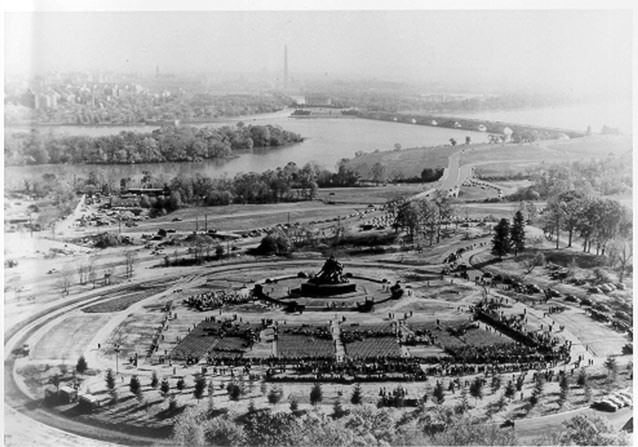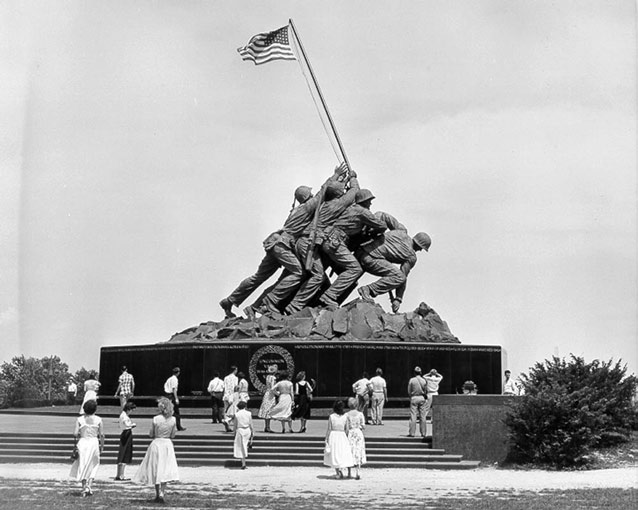With its elevated view of the District of Columbia, the Arlington Ridge Park site has been regarded as a prime location for several memorials. The landscape is situated on a ridge above the Potomac River in Arlington, Virginia. It contains two major memorials and their associated designed landscapes.
Arlington Ridge Park was acquired by the National Park Service in 1953 to protect the west end of the National Mall from the visual intrusion of development in Virginia. The first memorial to be built was the U.S. Marine Corps.

NPS/George Washington Memorial Parkway library (Defense Department aerial photo KVI-537)
Arlington Ridge Park is situated on a ridge above the Potomac River in Arlington, Virginia. The 27.5-acre site is part of a larger national park, the George Washington Memorial Parkway. Arlington National Cemetery is just south of the park landscape, bordered by a historic red sandstone wall.
Arlington Ridge Park contains two major memorials and their distinct landscape areas. The 1954 U.S. Marine Corps War Memorial, a monumental realistic sculpture by Felix de Weldon, was inspired by the iconic World War II photograph by Joseph Rosenthal showing five Marines and a Navy corpsman raising the American flag on the island of Iwo Jima. The monument stands as a reminder of this event, which marked a turning point in the war in the South Pacific.
The Marine Corps War Memorial forms the centerpiece of a symmetrical, formal landscape plan, which was designed by architect Horace Peaslee. The statue stands on a raised plaza, paved in a decorative concrete developed by the John J. Earley Studios.
With its elevated view of the District of Columbia, the site has been regarded as a prime location for several memorials. In between the two existing monuments, The Freedom Shrine was planned as an auditorium-like structure dedicated to the basic rights guaranteed by the Bill of Rights. The third memorial never received funding and plans were abandoned.

NPS
To the south stands the 1960 Netherlands Carillon, designed by Dutch architect Joost W.C. Boks. The Modernist steel framework containing a memorial carillon was presented to the U.S. by the people of the Netherlands in gratitude for American aid given during World War II.
The de Weldon statue stands on a raised plaza, paved in decorative concrete. North of this, the parade ground is a rectangular area of lawn used by the Marines for “sunset parades,” which are held during the summer months. A reviewing stand rises on the far side of the parade ground. The plaza, parade ground, and reviewing stand are linked by tree-lined paths and surrounded by a loop road.
Behind the stand, a line of sour gum trees is arranged in front of a grove of white pines planted on a berm. The sour gum’s fall coloring, in combination with the dark green of the pines, acts as a backdrop that throws the statue into relief when viewed from across the river.
The Netherlands Carillon stands in the center of a plaza at the top of a slope. The open lawns surrounding the carillon are planted with irregular lines of ornamental trees, which creates a naturalistic framework for the structure. The tree-planting plan was prepared by National Capital Parks landscape architects in the early 1960s. A pair of stylized lions by Dutch sculptor Paul Doning stands in front of the carillon at the entrance to the plaza.
Views are integral to all aspects of Arlington Ridge Park. The landscape is located on axis with the National Mall and just north of Arlington National Cemetery. Certain vantage points within the park were calculated to dramatize this visual connection, although invasive vegetation, highway signage construction, and heavy traffic interfere with some of these critical views.

NPS/George Washington Memorial Parkway files
The commemorative, ceremonial landscape of Arlington Ridge Park attracts visitors from throughout the United States and abroad. It also functions as a neighborhood park for nearby residents.
The U.S. Marine Corps War Memorial invites solemn contemplation of the sacrifices made in battle by Marines since the inception of the corps over 200 years ago. More casual activities are enjoyed on the lawns around the Netherlands Carillon. Activities in the park include ceremonial maneuvers by the Marines, concerts and picnics, and strolling along the memorial grounds.
Quick Facts
- Cultural Landscape Type: Designed
- National Register Significance Level: National
- National Register Significance Criteria: A,C
- Period of Significance: 1954-1964
Landscape Links
Last updated: October 7, 2021
